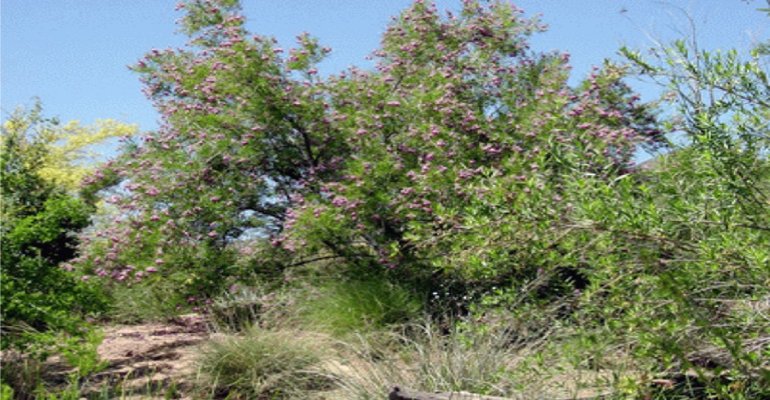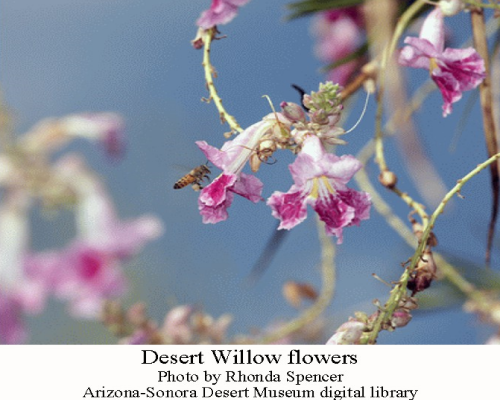
Desert willows (Chilopsis linearis) are trees that grow up to about 30 feet high. They range from southern California and Nevada, through Arizona and New Mexico to west Texas and northern Mexico. The primary habitat is low desert to grasslands.
Desert willows are not really willows, they are in the begonia family. However, their long slender leaves and drooping branches give them an appearance similar to willows.
 With sufficient rainfall, these trees bloom from mid-spring through mid-summer. The large, trumpet-shaped flowers are white in the western part of the willow’s range, but become progressively purple with yellow nectar guides in the eastern part of the range. Large bees are the main pollinators, but the flowers also attract other insects and hummingbirds.
With sufficient rainfall, these trees bloom from mid-spring through mid-summer. The large, trumpet-shaped flowers are white in the western part of the willow’s range, but become progressively purple with yellow nectar guides in the eastern part of the range. Large bees are the main pollinators, but the flowers also attract other insects and hummingbirds.
The Arizona-Sonora Desert Museum (ASDM) notes that desert willows are one of the few trees in the northern part of the Sonoran Desert that is not in the legume family. Desert willows do, however, produce seed pods 4 to 12 inches long which mature in Autumn. Then the brown pods split in two and release many flat seeds that have dual hair wings. See seed pods herehttp://medplant.nmsu.edu/chilopsis.shtm. The pods themselves often stay on the tree until the next spring.
Use as food:
ASDM says the bitter inner bark may be eaten raw as an emergency food. It tastes better when dried and ground to flour. The USDA says that the flower blossoms and seed pods were used for food also.
Medicinal use:
ASDM notes: “The Pima and Tarahumara make a decoction of the leaves and bark that they drink for fever.” Willow bark is an astringent and good as a gargle for sore throats. It has been used for hay fever, colds and as an expectorant. “Willow tea is used to treat heartburn, stomach problems, diarrhea, cramps, bladder infections and dandruff.”
USDA notes: The flowers, leaves, and bark of desert willow were used in hot poultices and to make a soothing tea for coughs. A tea concocted from the flowers produces a natural anti-oxidant which promotes cardiovascular health and regulates glucose metabolism. It was also used in preparations to guard against yeast infections, athlete’s foot and as a first aid for scrapes and scratches.
Other uses:
USDA says that “The bark was used to make fabrics for shirts and breechclouts, and fashioned into cordage to make nets. Branches were stripped of their bark and used as rod foundations for coil basketry. The wood was used in building house frames, granaries and fence posts.”
USFS notes that “Unlike the weak wood of true willows, the wood of Desert-Willow was used by Indians to craft their hunting bows.”
Xeriscaping:
According to Arid Zone Trees: “The Arizona Department of Water Resources recommends desert willow as a low water use/drought-tolerant tree. Keep in mind though, that monthly irrigation during the summer months maximizes the desert willow’s ornamental value. Moderate water use is beneficial, but not critical for survival of the tree. Desert willow is no wimp. It is hardy to minus 10 degrees Fahrenheit, has deep roots that extend 50’+, waxy leaves that effectively retain moisture, and is highly responsive to cold and drought. The first hard frost will disrobe the entire tree. Have no fear because fresh leaves ‘spring-out’ during March through May.”
Related articles:
Mesquite trees provide food, fuel, medicine, and more
The Jojoba bush and its valuable oil
Yuccas provide food, fiber, and soap
Note to readers: I have constructed a linked index to more than 300 of my ADI articles. You can see it at: https://wryheat.wordpress.com/adi-index/
Have a look and see if there is some natural history subject of interest I haven’t yet written about.
